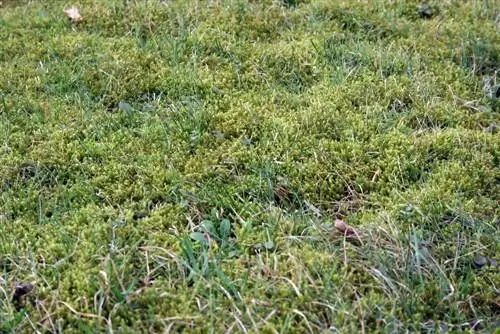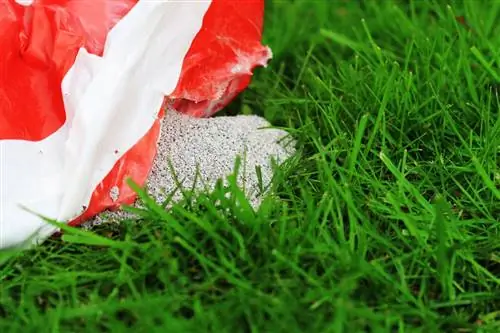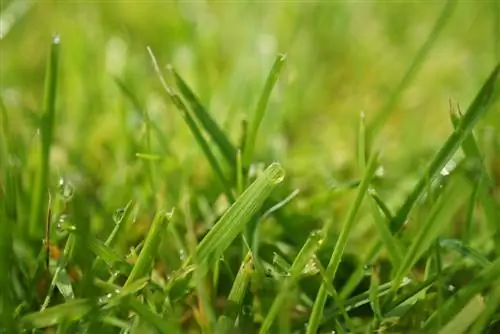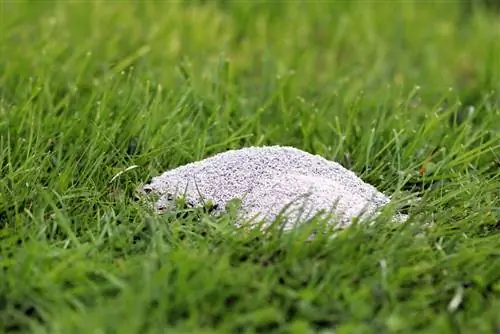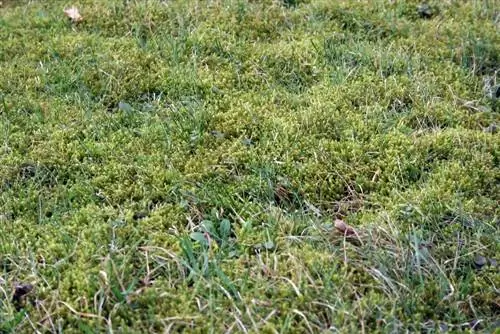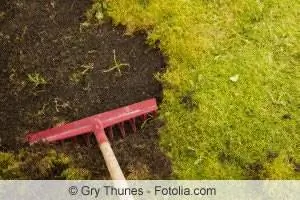- Author admin [email protected].
- Public 2023-12-17 03:39.
- Last modified 2025-01-24 12:45.
A lawn on which large areas of moss forms usually destroys the decorative appearance of the entire garden. Therefore, nothing else can help here other than to permanently combat the moss. Lime nitrogen can be used against this, the blades of grass then have the chance to grow over the entire area and a beautiful, green, continuous carpet of lawn is created.
How does moss form in the lawn?
Especially when the lawn is very shady and damp, the unwanted moss appears. If it is not controlled, over time it will displace the grasses and spread further and further. The moss has a great advantage, especially on weakened lawns that are not exposed to optimal conditions. It is important that the pH value of the soil is adjusted so that the moss no longer feels comfortable there. Especially when the soil is too acidic, the grass is pushed back by the moss. Care errors, for example because the lawn was not scarified and therefore not enough air gets to the roots, can also be the cause of moss formation.
Benefits of calcium cyanamide
If lime nitrogen is used correctly, it can create a beautiful, dense lawn in which moss has no chance. Calcium cyanamide offers the following advantages in particular:
- he althy soil
- Spread of disease pathogens is prevented
- is only gradually converted into the soil
- is therefore available to the grass for a long time
- Growth of grass is promoted
- Sod becomes denser and more durable
- Moss is pushed back
- Other weeds can also be controlled in this way
Time
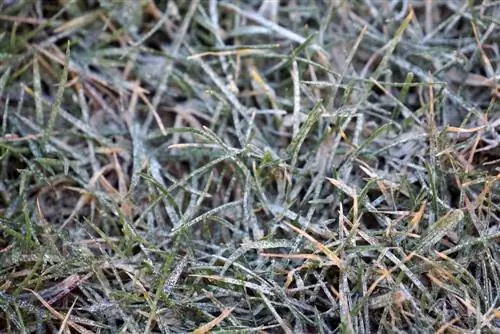
The right time to strengthen and fertilize the lawn, especially to counteract the moss that has formed over the wet winter months, is spring. There should definitely be good preparation with the first lawn cutting and large-area scarification. Otherwise, the day of fertilization should look like this:
- frost-free
- When there is frost, the fertilizer is not absorbed into the soil
- dry
- if it rains, the grass is wet too
- however, this should be avoided
- however, the soil should be moist
- overcast
- Sunlight can also promote burning
Tip:
Even if the lime nitrogen is to be applied to slightly moist soil, the plants should not be moist. It is therefore recommended to wait a day after rain to fertilize. Because then the ground is still sufficiently moist, but the grass has already been able to dry out again.
Calculate fertilizer amount
In order to determine the right amount for the existing lawn, the size must be determined. If you don't know what size your lawn is, you can walk across it in large steps in a crosswise and lengthwise direction. An adult's sweeping step is approximately one meter. To determine the square meters, proceed as follows:
- Counting longitudinal steps
- Counting lateral steps
- multiply together
- results in the total square meter area
- multiply this by the fertilizer application per square meter
- Information for this is on the packaging
- usually it is 20 g/m²
This results in the following example calculation:
5 meters long x 3 meters wide results in a square meter area of 15 m². This is now multiplied by 20, resulting in a total number of grams of 300 g needed for the lawn.
Tip:
If scales are not available, there is a little trick for measuring the fertilizer. Either you can take the calculated amount from the packaging with a tablespoon. The rule here is that one heaped tablespoon corresponds to around 20 g of calcium cyanamide. For a measuring cup, 100 ml of measured calcium cyanamide weighs 100 g.
Procedure for fertilizing
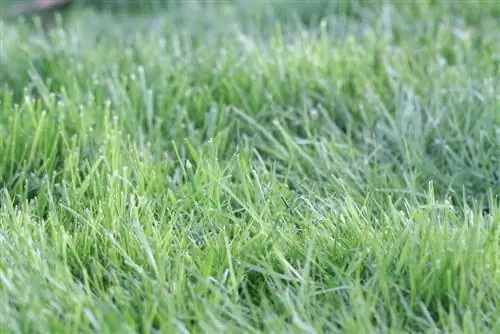
Once the appropriate amount has been determined, it is spread over the area. This works best with a spreader. The lime nitrogen is added here and the area is then driven over row by row, with the trolley scattering the fertilizer evenly over the lawn. If it is only a small area or there is no spreader available, then you should proceed as follows:
- Wear gloves
- Put fertilizer in a bucket
- always take a handful of fertilizer
- throw this one from your wrist
- always diagonally upwards and forwards
- so the little grains fly apart easily
If the entire lawn area has been fertilized, it must be kept well moist over the next few days. Otherwise the fertilizer will not dissolve properly and can cause extensive burns on the lawn.
Tip:
Lawn areas are ideally sprinkled twice. The second time should then be repeated one to two weeks after the first spreading with the same amount of calcium cyanamide.
Use the spreader correctly
If a spreader is used, the correct dosage should be checked before fertilizing the lawn with lime nitrogen to combat moss. There is the following, very simple method for this:
- Use daily newspaper
- Place the double page on the floor
- corresponds to approximately 57 cm x 80 cm
- almost half a square meter
- drive the filled spreader twice over newspaper
The amount of fertilizer on it now corresponds to the amount of lime nitrogen that the spreader spreads over an area of one square meter. This depends above all on the respective spreading width of the spreader. Close the newspaper and measure or weigh the fertilizer on it. This prevents the spreader from applying too much fertilizer.
Caution when using
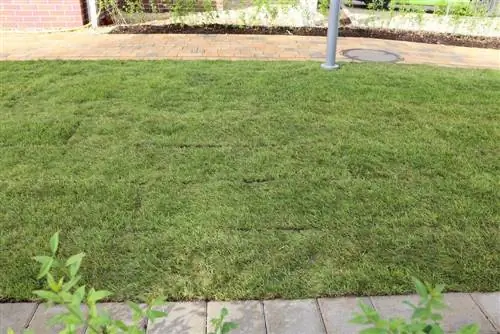
Limetic nitrogen should only be applied to the lawn with precautionary measures and the greatest care. If you overdose or use it incorrectly, the entire lawn and not just the moss in it can suffer. If the lawn is over-fertilized with lime nitrogen, serious burns will occur. Even a young, newly sown lawn cannot tolerate this fertilization. To prevent moss from forming, it is better to prepare the lawn accordingly a few weeks before sowing. Therefore, when using calcium cyanamide, the following should always be observed:
- work correctly
- a lot doesn't always help a lot
- do not exceed recommended quantity
- spread evenly
- Ideally use gritters
Especially if there are pets or small children in the household, they should not be nearby while the litter is being spread. The hobby gardener himself should always protect himself with rubber gloves when working with the highly concentrated mixture and make sure that nothing gets into his eyes. It is important to strictly follow the manufacturer's safety instructions.
Tip:
If you don't have your own spreader available or don't want to buy one, these devices can be rented on a daily basis from a well-stocked garden store.
Avoidable errors
If there are burns on the lawn after fertilizing, then this is primarily due to avoidable mistakes. The burns can have the following causes:
- Overdose
- never apply more than 30 g/m² of lime nitrogen
- Distribution uneven
- pay attention to overlaps on spreaders
- on wet grass, grains stick to the blades of grass
- newly sown lawn area
- never fertilize in the first year of sowing
If a lawn has suffered burns from lime nitrogen, it is not certain whether it will recover. This depends primarily on the degree of burns. The lawn should now be kept moist and not allowed to dry out. Normally the grasses recover from the rootstock. If there are no new shoots after about four weeks, the lawn will no longer recover in these areas and will have to be sown again.

